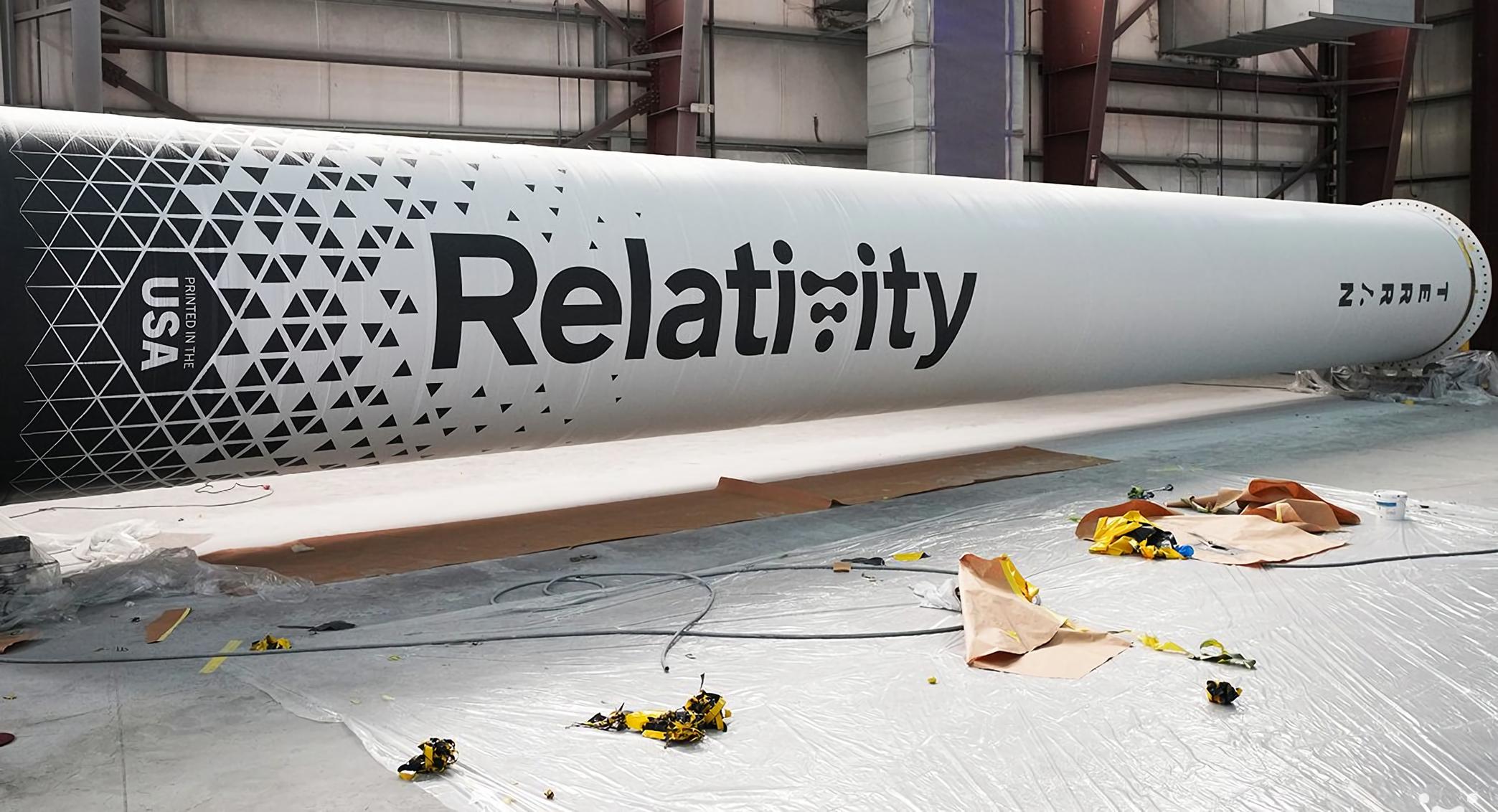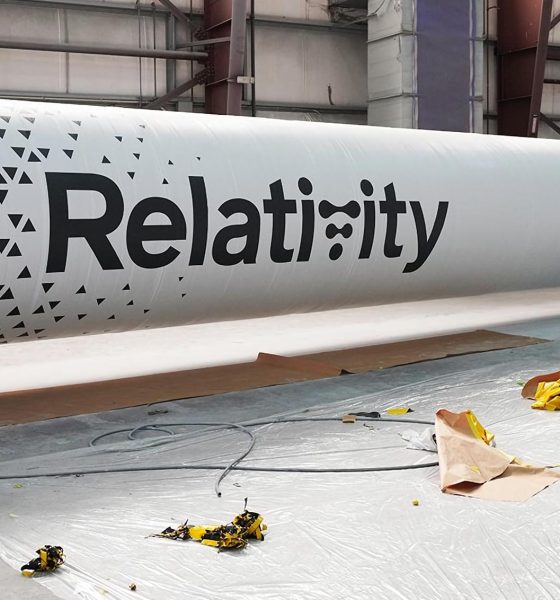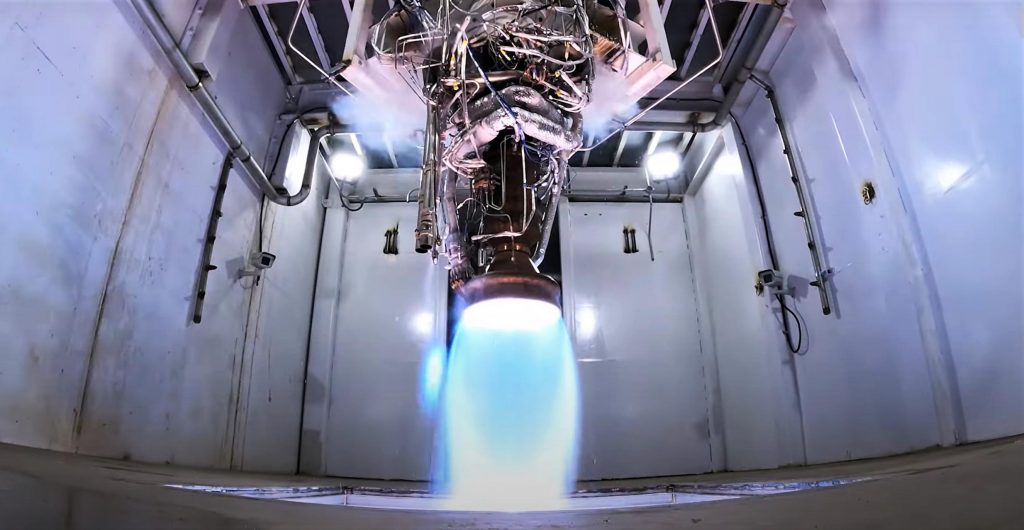

News
Relativity Space “closer and closer” to first launch of a fully 3D-printed rocket
Relativity Space, a Long Beach, California-based aerospace startup, aims to alter the manufacturing process of rockets forever by 3D-printing almost every piece of their orbital-class Terran rockets.
The company was co-founded in 2015 by CEO Tim Ellis (departing Blue Origin) and Jordan Noone (departing SpaceX), with both engineers leaving their positions at these industry giants with one goal in mind: build and launch the world’s first 3D-printed orbital rocket.
In the last two and a half years, the startup has managed to raise nearly $1.3 billion through private investors including Baillie Gifford, Blackrock, BOND, Fidelity, General Catalyst, and Mark Cuban. That amount of investment makes Relativity one of the most valuable and best-funded private aerospace companies in recent history – second only to Elon Musk’s SpaceX, which has raised more than $7.7 billion in about a decade.
Relativity’s rocket manufacturing facility, “The Factory of the Future,” is located in Long Beach, California, and is home to Stargate – the world’s largest 3D printer. According to Ellis, Stargate is capable of printing virtually all of the parts required for the world’s first 3D-printed rocket, Terran 1, and the first fully reusable 3D-printed rocket, Terran R, from raw material to flight in just 60 days. To accomplish that unprecedented feat and create the largest metallic 3D-printed structures ever attempted, Relativity has developed multiple proprietary alloys.
Beyond its extremely exotic manufacturing approach, Terran 1 is a fairly standard two-stage rocket primarily designed to launch small satellites to low Earth orbit (LEO). The first stage is powered by nine Aeon 1 engines, each producing around 23,000 pounds of force (100 kN) at launch and 25,400 lbf (113 kN) in the vacuum of space. The engine is powered by liquid methane (LCH4) and liquid oxygen (LOx) and is made out of several proprietary 3D-printed alloys. The second stage is powered by one Aeon 1 Vacuum engine capable of producing up to 28,300 lbf (126 kN) of thrust in a vacuum thanks to a much larger nozzle. Terran 1 is designed to carry up to 1,250 kilograms to a very low Earth orbit (LEO).

Relativity is growing quickly and has expanded to nearly 600 employees in just a few years. Aside from their headquarters and manufacturing facility in Long Beach, CA, Relativity has planted their flag at Cape Canaveral Space Force Station (CCSFS), where it’s developing Launch Complex 16 (LC-16) for Terran 1 and Terran R. There, a team of infrastructure engineers and technicians are currently building the launch facilities that will support Terran 1’s launch debut. A separate team at Mississippi’s NASA Stennis Space Center is continually testing the startup’s engines and rocket stages.
In a recent tweet, CEO Tim Ellis revealed that the company had completed a record nine successful Aeon engine tests in a single day. The CEO also stated that stage integration for Terran 1’s launch debut was making “amazing progress.”
Relativity had previously planned for Terran 1’s first launch to take place by the end of 2021. That debut has since slipped to “early 2022”, while the company hopes its far larger reusable Terran R rocket will debut in 2024.
Relativity was recently selected by NASA to be one of 12 companies to provide launch services for the agency’s Venture-Class Acquisition of Dedicated and Rideshare (VADR) missions, providing new opportunities for more risk-tolerant science and technology payloads and fostering a growing U.S. commercial launch market. “The VADR contract will provide a broad range of Federal Aviation Administration-licensed commercial launch services capable of delivering payloads ranging from CubeSats to Class D missions to a variety of orbits. These small satellites and Class D payloads tolerate relatively high risk and serve as an ideal platform for technical and architecture innovation, contributing to NASA’s science research and technology development.”

News
Elon Musk’s Grokipedia surges to 5.6M articles, almost 79% of English Wikipedia
The explosive growth marks a major milestone for the AI-powered online encyclopedia, which was launched by Elon Musk’s xAI just months ago.

Elon Musk’s Grokipedia has grown to an impressive 5,615,201 articles as of today, closing in on 79% of the English Wikipedia’s current total of 7,119,376 articles.
The explosive growth marks a major milestone for the AI-powered online encyclopedia, which was launched by Elon Musk’s xAI just months ago. Needless to say, it would only be a matter of time before Grokipedia exceeds English Wikipedia in sheer volume.
Grokipedia’s rapid growth
xAI’s vision for Grokipedia emphasizes neutrality, while Grok’s reasoning capabilities allow for fast drafting and fact-checking. When Elon Musk announced the initiative in late September 2025, he noted that Grokipedia would be an improvement to Wikipedia because it would be designed to avoid bias.
At the time, Musk noted that Grokipedia “is a necessary step towards the xAI goal of understanding the Universe.”
Grokipedia was launched in late October, and while xAI was careful to list it only as Version 0.1 at the time, the online encyclopedia immediately earned praise. Wikipedia co-founder Larry Sanger highlighted the project’s innovative approach, noting how it leverages AI to fill knowledge gaps and enable rapid updates. Netizens also observed how Grokipedia tends to present articles in a more objective manner compared to Wikipedia, which is edited by humans.
Elon Musk’s ambitious plans
With 5,615,201 total articles, Grokipedia has now grown to almost 79% of English Wikipedia’s article base. This is incredibly quick, though Grokipedia remains text-only for now. xAI, for its part, has now updated the online encyclopedia’s iteration to v0.2.
Elon Musk has shared bold ideas for Grokipedia, including sending a record of the entire knowledge base to space as part of xAI’s mission to preserve and expand human understanding. At some point, Musk stated that Grokipedia will be renamed to Encyclopedia Galactica, and it will be sent to the cosmos.
“When Grokipedia is good enough (long way to go), we will change the name to Encyclopedia Galactica. It will be an open source distillation of all knowledge, including audio, images and video. Join xAI to help build the sci-fi version of the Library of Alexandria!” Musk wrote, adding in a later post that “Copies will be etched in stone and sent to the Moon, Mars and beyond. This time, it will not be lost.”
News
Tesla Model 3 becomes Netherlands’ best-selling used EV in 2025
More than one in ten second-hand electric cars sold in the country last year was a Tesla Model 3.

The Tesla Model 3 became the most popular used electric car in the Netherlands in 2025, cementing its dominance well beyond the country’s new-car market.
After years at the top of Dutch EV sales charts, the Model 3 now leads the country’s second-hand EV market by a wide margin, as record used-car purchases pushed electric vehicles further into the mainstream.
Model 3 takes a commanding lead
The Netherlands recorded more than 2.1 million used car sales last year, the highest level on record. Of those, roughly 4.8%, or about 102,000 vehicles, were electric. Within that growing segment, the Tesla Model 3 stood far ahead of its competitors.
In 2025 alone, 11,338 used Model 3s changed hands, giving the car an 11.1% share of the country’s entire used EV market. That means more than one in ten second-hand electric cars sold in the country last year was a Tesla Model 3, Auto Week Netherlands reported. The scale of its lead is striking: the gap between the Model 3 and the second-place finisher, the Volkswagen ID3, is more than 6,700 vehicles.
Rivals trail as residual values shape rankings
The Volkswagen ID.3 ranked a distant second, with 4,595 used units sold and a 4.5% market share. Close behind was the Audi e-tron, which placed third with 4,236 registrations. As noted by Auto Week Netherlands, relatively low residual values likely boosted the e-tron’s appeal in the used market, despite its higher original price.
Other strong performers included the Kia Niro, the Tesla Model Y, and the Hyundai Kona, highlighting continued demand for compact and midsize electric vehicles with proven range and reliability. No other model, however, came close to matching the Model 3’s scale or market presence.
News
Tesla Model Y Standard Long Range RWD launches in Europe
The update was announced by Tesla Europe & Middle East in a post on its official social media account on X.

Tesla has expanded the Model Y lineup in Europe with the introduction of the Standard Long Range RWD variant, which offers an impressive 657 km of WLTP range.
The update was announced by Tesla Europe & Middle East in a post on its official social media account on X.
Model Y Standard Long Range RWD Details
Tesla Europe & Middle East highlighted some of the Model Y Standard Long Range RWD’s most notable specs, from its 657 km of WLTP range to its 2,118 liters of cargo volume. More importantly, Tesla also noted that the newly released variant only consumes 12.7 kWh per 100 km, making it the most efficient Model Y to date.
The Model Y Standard provides a lower entry point for consumers who wish to enter the Tesla ecosystem at the lowest possible price. While the Model 3 Standard is still more affordable, some consumers might prefer the Model Y Standard due to its larger size and crossover form factor. The fact that the Model Y Standard is equipped with Tesla’s AI4 computer also makes it ready for FSD’s eventual rollout to the region.
Top Gear’s Model Y Standard review
Top Gear‘s recent review of the Tesla Model Y Standard highlighted some of the vehicle’s most notable features, such as its impressive real-world range, stellar infotainment system, and spacious interior. As per the publication, the Model Y Standard still retains a lot of what makes Tesla’s vehicles well-rounded, even if it’s been equipped with a simplified interior.
Top Gear compared the Model Y Standard to its rivals in the same segment. “The introduction of the Standard trim brings the Model Y in line with the entry price of most of its closest competition. In fact, it’s actually cheaper than a Peugeot e-3008 and costs £5k less than an entry-level Audi Q4 e-tron. It also makes the Ford Mustang Mach-E look a little short with its higher entry price and worse range,” the publication wrote.








